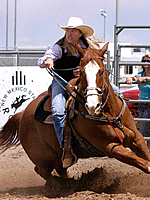
Hille, A.R. "Dick"AboutHille discusses coming to New Mexico in the 1920s. He worked on a number of ranches in southern New Mexico, and homesteaded in the 1930s. During World War II he worked in the defense industry, but returned to New Mexico in 1945. He started a welding business and also purchased two ranches in southern New Mexico.
Abstract
Tape 1, Side A
Born in Portage La Prairie, Manitoba to German immigrant parents in 1908. The family emigrated from Canada to Philadelphia, and then in 1925, Hille traveled by himself to Arizona and New Mexico. Work was difficult to obtain. He worked as a cowboy on several ranches in southern New Mexico, and then broke his leg training horses. He went to work for a dairy, and the family encouraged him to finish high school, which he did in 1935. In 1935 he homesteaded in Seco Canyon. Hand dug a 75-foot well and built an adobe house. He proved up on his homestead in 1938. He worked for wages for many years, and looked after the ranch on weekends, or had a friend take care of the cattle. Hille states that the summer of 1996 is one of the worst drought years he can remember. He did not sell any of his cattle in the 1930s when the federal government was purchasing them for slaughter. In the 1940s (after the start of World War II) the Hilles sold their homestead to the Hopkins. He was deferred from the draft as long as he continued to work in a defense industry. He worked for North American Aircraft in Dallas and then later worked for a company in Pennsylvania that was producing tank destroyers and tanks.
Tape 1, Side B
After the war, Hille returned to New Mexico, and bought a ranch (in 1945) that adjoined Elephant Butte Lake. He described the ranch as a "desert ranch." They sold this property and moved to Las Cruces and opened a welding shop. In 1959 they purchased the ranch they currently own. They raise black brangus on the ranch, and red brangus on another ranch they purchased in the Caballos Mountains. At the time of the taping drought conditions were severe, and Hille was supplementally feeding his cattle, and had shipped some of them to Texas' pastures. Discusses the changes in the sense of community in the rural areas. There are no longer as many families needed to do the ranch work due to changes in technology, and this, he believes, has had a great impact. He is concerned about the future of ranching, because of over-regulation and the impact of imported cattle from Mexico and Canada on the domestic market. |

